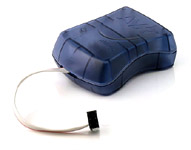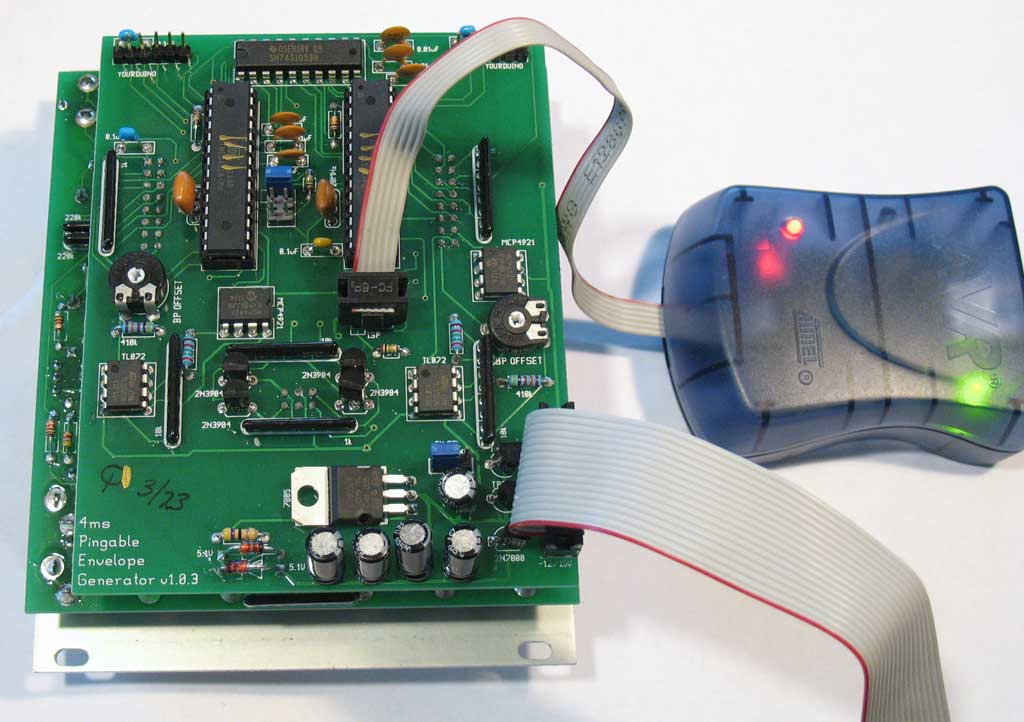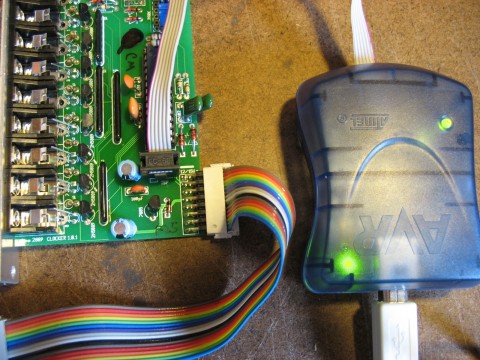A number of 4ms devices use an AVR microcontroller. These chips run a small program. On most 4ms devices that use an AVR chip, there’s a 6-pin header (2 rows of 3 pins) near the chip. This header lets you update, upgrade, or hack the AVR chip.
Here’s how to do it:
You will need…
-

AVR ISP mk2 ISP (In-circuit Programmer): I recommend the AVRISP2 (also known as AVR ISP MKII) available from atmel.com, or Mouser for $34, or ebay and amazon sometimes. In Europe, try Farnell
- A computer with a USB port. Windows actually has the most seamless installer, but I also use Mac and Linux to burn code. Download and install one of these:
- Windows: AVR Studio 4.19. Download it here: AVR Studio Archives. (Note that the latest version is AVR Studio 6, which will probably work, but these instructions are geared for AVR Studio 4)
- Mac OS X:
- Method 1: Install homebrew by following this guide (a one-line installation). Then type “brew install avrdude” into the Terminal and press enter. Then you can install AVRFuses (see below for how to set the AVR Fuses preferences)
- Method 2: Download and install Crosspack-AVR and then AVRFuses
- Linux: You just need the avrdude program to burn code, but can install the whole avr-gcc toolchain if you might be compiling your own firmware.
- The hex file: This is the actual file that contains the firmware update. If you’re upgrading a device, this will be available for download on the device’s web page, or you can find alternative firmwares on the 4ms github. If you’re an advanced hacker, you’ll probably compile your own code using avr-gcc (part of AVR Studio and Crosspack) which will generate a hex file for you. The file should be in intel hex format, ending in .hex
- Quad Clock Distributor (v1: double-stack green PCB)
- Quad Clock Distributor (v2.x: single black PCB)
- Pingable Envelope Generator (v1.x, and kits)
- Pingable Envelope Generator (v2.x)
- Rotating Clock Divider
- Shuffling Clock Multiplier
- Autonomous Bassline Generator
- Bend Matrix
Specific instructions for PEG:
If you’re programming a PEG, read this article specifically about the PEG before continuing.

Specific instructions for QCD:
The QCD has four ATtiny85 chips: one for the tap button and one for each of the four channels. Each chip has its own 6-pin ISP header.
The tap button chip can be programmed normally. It’s marked with a white dot and is located under the tap button and jack. (At this time, the firmware for the tap button is not available)
To program the channels, you must apply a gate signal to the Reset and CLK IN jack for the channel you’re programming. The gate signal should be 5V or more. Note: It’s usually fine to use a passive mult to split one gate signal to all the Reset and CLK IN jacks.
Specific instructions for QPLFO:
The QPLFO has four ATtiny85 chips: one for each channel. Each chip has its own 6-pin ISP header.
To program the channels, you must apply a gate signal to the Reset and Ping jack for the channel you’re programming. The gate signal should be 5V or more. Note: It’s usually fine to use a passive mult to split one gate signal to all the Reset and Ping jacks.
Detailed Instructions:
Windows (AVR Studio 4):
- Download and installAVR Studio 4.19 from the AVR Studio Archives.
- Run the installer and click OK/Next to everything. Yes, you want the “Jungo/USB” driver to be installed.
- Plug in your AVR ISP mkII into the USB port and make sure Windows finds it, and automatically installs the drivers. The green light near the USB plug should come on.
- Power your device up (that is, plug your Rotating Clock Divider into your Eurorack system, or power up your Bend Matrix, etc…). Your device should be running normally, but don’t plug any patch cables into it
- Plug the 6-pin ISP header of the AVRISP mkII into your device. Note the orientation: the red stripe should go towards the white box that’s printed on the PCB: see photo above.
- The light near the 6-pin cable on the AVRISP mkII should turn green, indicating that it detects power. If you plugged it in backwards, it might flash orange. Nothing’s damaged, just flip it around…
- Run AVRStudio 4
- Click the little “AVR Programmer” icon:

- If it doesn’t automatically detect your AVR ISP mkII, then select it from the box on the left, and click “USB”, and then click “Connect…”
- Click on the “Main” tab, and select “ISP mode” from the bottom box. Click “Settings” and choose an ISP Frequency of 125kHz.
- Select the chip you’re programming under “Device and Signature Bytes”:
- Select “ATmega168” for the RCD or SCM
- ATtiny84 for the Auto Bass Gen
- ATmega32 for the Bend Matrix
- ATmega328 for the PEG
- ATtiny85 for the QPLFO or QCD channels
- ATtiny2313 for the QPLFO tap controller
- Click “Read Signature” and it should say “Signature matches device”
- Click the “Program” tab. Under “Flash” click the “…” button next to “Input HEX File” (the top one). Make sure you’re not under EEPROM! Select your hex file that you downloaded (or compiled yourself)
- Now, click “Program” (under the Flash section, not under the EEPROM section). It should give you no errors at the bottom of the window
- Unplug your ISP 6-pin header and you should be good to go!
Please let me know if you have any problems!
Mac OSX (AVR Fuses) –the easy way to upgrade your firmware:
Method 1: Install homebrew by opening up Terminal and typing:
ruby -e "$(curl -fsSL https://raw.githubusercontent.com/Homebrew/install/master/install)"(all on one line). Then press enter. When it’s done, type:
-
brew install avrdude
and press enter.
Or… do Method 2: Download and install Crosspack-AVR
- Download and install AVR Fuses.
- Select File->Preferences in AVR Fuses.
- Set the location of avrdude (it probably will be /usr/local/bin/avrdude).
- Set Programmer to “avrispmkII”
- Set Port to usb
- Set Bit Clock to 8
- Download the hex file for your upgrade from 4mspedals.com
- Plug in your AVR ISP mkII. The green light by the USB plug might not come on.
- Do steps 4, 5, and 6 of the Windows installation (power up your device, plug in the AVR ISP mkII, make sure the green light comes on)
- Open up AVR Fuses.
- Select the AVR chip type that you’re using (the name of the chip is also printed on the chip itself, use a flashlight to read the tiny letters!)
- Pingable Envelope Generator (PEG) uses ATMEGA328
Bend Matrix uses ATMEGA32 or ATMEGA32A
RCD and SCM: ATMEGA168 or ATMEGA168P
AutoBassGen: ATTINY84 - Select the hex file you downlaoded in step 2, and burn it onto your chip!
Mac OSX (Crosspack) –the advanced way to hack your code:
- Download and install Crosspack from here: http://www.obdev.at/products/crosspack/index.html]
- Download the hex file for your upgrade. Save the file in your Home directory, so you can find it easily with the Terminal.
- Plug in your AVR ISP mkII. The green light by the USB plug might not come on.
- Do steps 4, 5, and 6 of the Windows installation (power up your device, plug in the AVR ISP mkII, make sure the green light comes on)
- Open up your Terminal program (in Utilities folder)
- In Terminal, type “ls” and hit enter. You should see the name of the hex file that you saved in your Home directory (along with everything else in your Home directory). If not, you didn’t save it in the right place.
- Now tell it to burn the code. For the RCD, type this command (all on one line)
avrdude -P usb -c avrispmkII -p atmega168 -U flash:w:clocker.hex -v -v
And press enter. This assumes your hex file is named “clocker.hex”. It should say “avrdude: Thank you” and have no errors above that. If all goes well, unplug your 6-pin cable and your RCD is updated!
If you’re using a fresh chip, you’ll need to use this command to burn the fuses:
avrdude -P usb -c avrispmkII -p atmega168 -U hfuse:w:0xd7:m -U lfuse:w:0xef:m -U efuse:w:0x01:m -U flash:w:clocker.hex
Linux:
- Install avrdude. You can probably install it with your package manager, such as Aptitude: (type “sudo aptitude install avrdude”), or Ubuntu’s Synaptic
- Follow the OSX instructions starting at step 2. Hint, if avrdude is not finding a usb connection, you might need to type “sudo” before the avrdude commands. Then it’ll ask you for your password before running avrdude.






